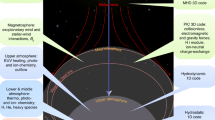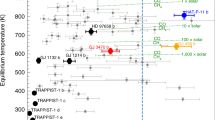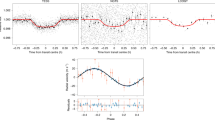Abstract
Giant exoplanets orbiting close to their host stars have high temperatures because of the immense amount of stellar irradiation that they receive. The extreme energy input leads to the expansion of the atmosphere and the escape of neutral hydrogen1,2,3. An intriguing case among the hot giant planets is KELT-9b, an exoplanet orbiting very close to an early A-type star, with the highest temperature (around 4,600 K on the day-side) of any exoplanet known so far4. The atmospheric composition and dynamics of this planet have previously been unknown. Here we report the detection of an extended hot hydrogen atmosphere around KELT-9b. The detection was achieved by measuring the atomic hydrogen absorption during transit by observing the Balmer Hα line, which is unusually strong, mainly owing to the high level of extreme-ultraviolet radiation from the star. We detected a wavelength shift of the Hα absorption that is mostly attributed to the planetary orbital motion5. The obtained transmission spectrum has a noticeable line contrast (1.15% extra absorption at the Hα line centre). The observation implies that the effective radius at the Hα line centre is about 1.64 times the size of the planetary radius, indicating that the planet has an extended hydrogen envelope close to the size of the Roche lobe (\(1.9{1}_{-0.26}^{+0.22}{R}_{{\rm{planet}}}\)) and is probably undergoing substantial escape of its atmosphere.
This is a preview of subscription content, access via your institution
Access options
Access Nature and 54 other Nature Portfolio journals
Get Nature+, our best-value online-access subscription
$29.99 / 30 days
cancel any time
Subscribe to this journal
Receive 12 digital issues and online access to articles
$119.00 per year
only $9.92 per issue
Buy this article
- Purchase on Springer Link
- Instant access to full article PDF
Prices may be subject to local taxes which are calculated during checkout



Similar content being viewed by others
References
Vidal-Madjar, A. et al. An extended upper atmosphere around the extrasolar planet HD209458b. Nature 422, 143–146 (2003).
Ballester, G. E., Sing, D. K. & Herbert, F. The signature of hot hydrogen in the atmosphere of the extrasolar planet HD 209458b. Nature 445, 511–514 (2007).
Ehrenreich, D. et al. A giant comet-like cloud of hydrogen escaping the warm Neptune-mass exoplanet GJ 436b. Nature 522, 459–461 (2015).
Gaudi, B. S. et al. A giant planet undergoing extreme-ultraviolet irradiation by its hot massive-star host. Nature 546, 514–518 (2017).
Snellen, I. A. G., de Kok, R. J., de Mooij, E. J. W. & Albrecht, S. The orbital motion, absolute mass and high-altitude winds of exoplanet HD209458b. Nature 465, 1049–1051 (2010).
Quirrenbach, A. et al. CARMENES: an overview six months after first light. In Proc. SPIE 9908: G round-based and Airborne Instrumentation for Astronomy VI 990812 (SPIE, 2016).
Brogi, M. et al. Rotation and winds of exoplanet HD 189733 b measured with high-dispersion transmission spectroscopy. Astrophys. J. 817, 106 (2016).
Wyttenbach, A., Ehrenreich, D., Lovis, C., Udry, S. & Pepe, F. Spectrally resolved detection of sodium in the atmosphere of HD 189733b with the HARPS spectrograph. Astron. Astrophys. 577, A62 (2015).
Louden, T. & Wheatley, P. J. Spatially resolved eastward winds and rotation of HD 189733b. Astrophys. J. Lett. 814, L24 (2015).
Rossiter, R. A. On the detection of an effect of rotation during eclipse in the velocity of the brighter component of beta Lyrae, and on the constancy of velocity of this system. Astrophys. J. 60, 15–21 (1924).
McLaughlin, D. B. Some results of a spectrographic study of the Algol system. Astrophys. J. 60, 22–31 (1924).
Queloz, D. et al. Detection of a spectroscopic transit by the planet orbiting the star HD209458. Astron. Astrophys. 359, L13–L17 (2000).
Yan, F., Fosbury, R. A. E., Petr-Gotzens, M. G., Zhao, G. & Pallé, E. The centre-to-limb variations of solar Fraunhofer lines imprinted upon lunar eclipse spectra. Implications for exoplanet transit observations. Astron. Astrophys. 574, A94 (2015).
Czesla, S., Klocová, T., Khalafinejad, S., Wolter, U. & Schmitt, J. H. M. M. The center-to-limb variation across the Fraunhofer lines of HD 189733. Sampling the stellar spectrum using a transiting planet. Astron. Astrophys. 582, A51 (2015).
Yan, F., Pallé, E., Fosbury, R. A. E., Petr-Gotzens, M. G. & Henning, T. Effect of the stellar absorption line centre-to-limb variation on exoplanet transmission spectrum observations. Astron. Astrophys. 603, A73 (2017).
Foreman-Mackey, D., Hogg, D. W., Lang, D. & Goodman, J. emcee: The MCMC Hammer. Publ. Astron. Soc. Pacif. 125, 306 (2013).
Lecavelier des Etangs, A. et al. Temporal variations in the evaporating atmosphere of the exoplanet HD 189733b. Astron. Astrophys 543, L4 (2012).
Lavie, B. et al. The long egress of GJ 436b’s giant exosphere. Astron. Astrophys. 605, L7 (2017).
Jensen, A. G. et al. A detection of Hα in an exoplanetary exosphere. Astrophys. J. 751, 86 (2012).
Cauley, P. W. et al. Optical hydrogen absorption consistent with a thin bow shock leading the hot Jupiter HD 189733b. Astrophys. J. 810, 13 (2015).
Cauley, P. W., Redfield, S., Jensen, A. G. & Barman, T. Variation in the pre-transit Balmer line signal around the hot Jupiter HD 189733b. Astron. J. 152, 20 (2016).
Barnes, J. R., Haswell, C. A., Staab, D. & Anglada-Escudé, G. The origin of the excess transit absorption in the HD 189733 system: planet or star? Mon. Not. R. Astron. Soc. 462, 1012–1028 (2016).
Cauley, P. W., Redfield, S. & Jensen, A. G. A decade of Hα transits for HD 189733 b: stellar activity versus absorption in the extended atmosphere. Astron. J. 153, 217 (2017).
Christie, D., Arras, P. & Li, Z.-Y. Hα absorption in transiting exoplanet atmospheres. Astrophys. J. 772, 144 (2013).
Huang, C., Arras, P., Christie, D. & Li, Z.-Y. A model of the Hα and Na transmission spectrum of HD 189733b. Astrophys. J. 851, 150 (2017).
Shkolnik, E., Bohlender, D. A., Walker, G. A. H. & Collier Cameron, A. The on/off nature of star–planet interactions. Astrophys. J. 676, 628–638 (2008).
Tian, F., Toon, O. B., Pavlov, A. A. & De Sterck, H. Transonic hydrodynamic escape of hydrogen from extrasolar planetary atmospheres. Astrophys. J. 621, 1049–1060 (2005).
Lecavelier des Etangs, A. A diagram to determine the evaporation status of extrasolar planets. Astron. Astrophys. 461, 1185–1193 (2007).
Ehrenreich, D. et al. in Physics and Astrophysics of Planetary Systems (eds Montmerle, T. et al.) 429–440 (Publications Series 41, EAS, Les Ulis, 2010).
Salz, M., Czesla, S., Schneider, P. C. & Schmitt, J. H. M. M. Simulating the escaping atmospheres of hot gas planets in the solar neighborhood. Astron. Astrophys. 586, A75 (2016).
Caballero, J. A. et al. CARMENES: data flow. In Proc. SPIE 9910: Observatory Operations: Strategies, Processes, and Systems VI 99100E (SPIE, 2016).
Rothman, L. S. et al. The HITRAN 2008 molecular spectroscopic database. J. Quant. Spectrosc. Radiat. Transf. 110, 533–572 (2009).
Yan, F. et al. High-resolution transmission spectrum of the Earth’s atmosphere—seeing Earth as an exoplanet using a lunar eclipse. Int. J. Astrobiol. 14, 255–266 (2015).
Casasayas-Barris, N. et al. Detection of sodium in the atmosphere of WASP-69b. Astron. Astrophys. 608, A135 (2017).
Piskunov, N. & Valenti, J. A. Spectroscopy Made Easy: evolution. Astron. Astrophys. 597, A16 (2017).
Ryabchikova, T. et al. A major upgrade of the VALD database. Phys. Scripta 90, 054005 (2015).
Kurucz, R. ATLAS12, SYNTHE, ATLAS9, WIDTH9, et cetera. Mem. Soc. Astron. It. Suppl. 8, 14–24 (2005).
Acknowledgements
This work is based on observations collected at the German–Spanish Astronomical Center, Calar Alto, jointly operated by the Max-Planck-Institut für Astronomie Heidelberg and the Instituto de Astrofísica de Andalucía (CSIC). We thank Calar Alto Observatory for allocation of director’s discretionary time to this programme. We thank L. Nortmann for help in observing preparations and M. Samland for discussions on Monte Carlo analysis. We thank K. Molaverdikhani and C. Huang for discussions on the atmosphere model.
Author information
Authors and Affiliations
Contributions
F.Y. planned the observations, performed the data analysis and wrote the manuscript. T.H. contributed to preparations for observations and to writing the manuscript.
Corresponding author
Ethics declarations
Competing interests
The authors declare no competing interests.
Additional information
Publisher’s note: Springer Nature remains neutral with regard to jurisdictional claims in published maps and institutional affiliations.
Supplementary information
Supplementary Information
Supplementary Figures 1–4
Rights and permissions
About this article
Cite this article
Yan, F., Henning, T. An extended hydrogen envelope of the extremely hot giant exoplanet KELT-9b. Nat Astron 2, 714–718 (2018). https://doi.org/10.1038/s41550-018-0503-3
Received:
Accepted:
Published:
Issue Date:
DOI: https://doi.org/10.1038/s41550-018-0503-3
This article is cited by
-
Dynamics and clouds in planetary atmospheres from telescopic observations
The Astronomy and Astrophysics Review (2023)
-
High-resolution detection of neutral oxygen and non-LTE effects in the atmosphere of KELT-9b
Nature Astronomy (2021)
-
The evolution of the solar wind
Living Reviews in Solar Physics (2021)
-
Excited hydrogen detected in exciting gas giant
Nature Astronomy (2018)



